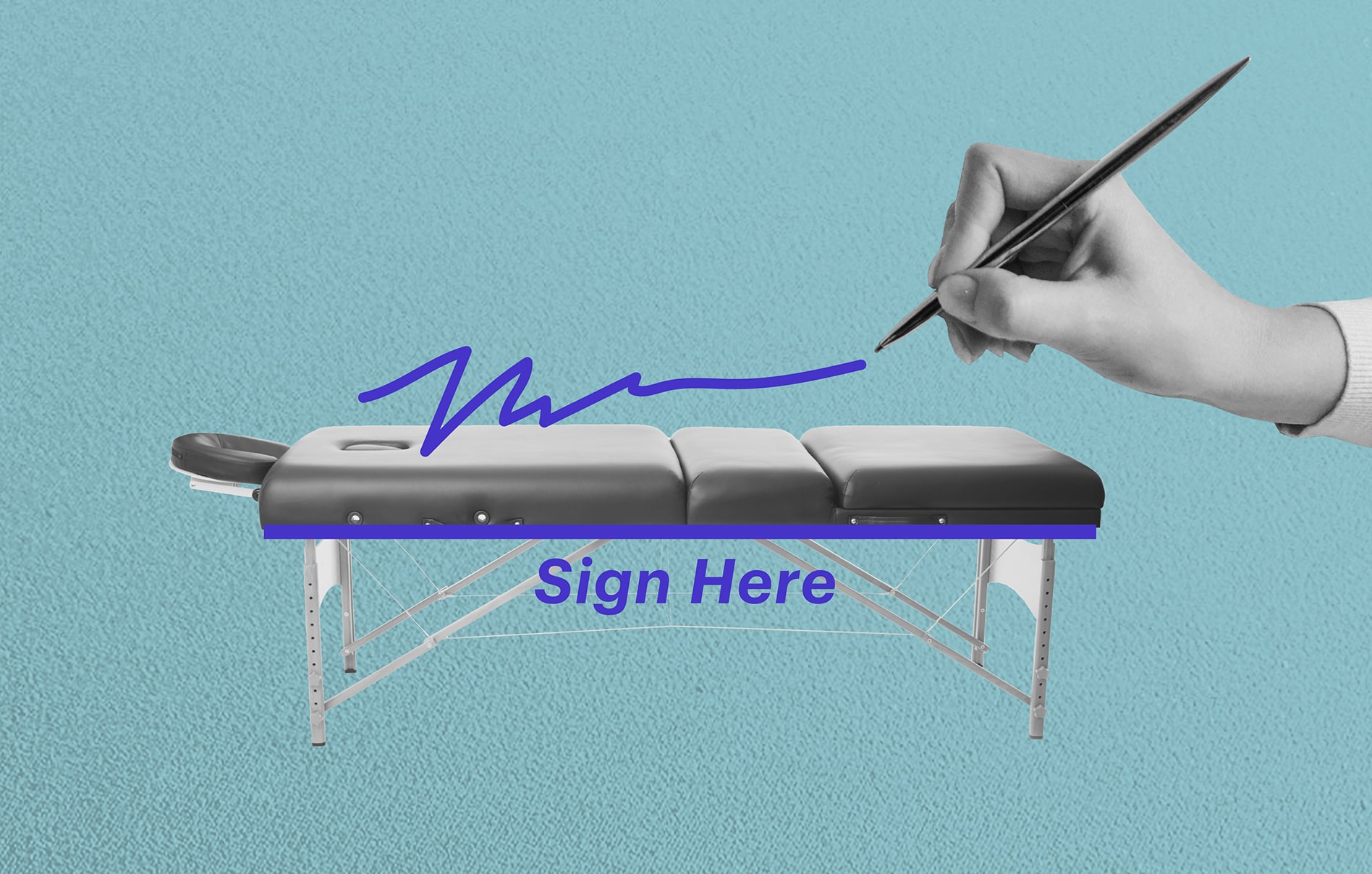Accepting health insurance as a massage therapist can give you an edge in a highly competitive industry.
But…
There are a few things to consider before you accept health insurance as an RMT.
We’ll help you understand what goes into accepting health insurance for your massage business, such as:
- State licensing requirements
- Proper insurance credentials
- Billing codes for filing claims
Plus, we’ll teach you how to talk to your massage clients about what their health insurance plan covers to avoid potential confusion or billing problems.
📚 Extra Credit: What’s the best massage scheduling software for solo therapists? Check out our free guide to massage scheduling software to find the right scheduling app for you!
Massage Therapy & Health Insurance: A Guide for Massage Therapists
- Understanding Massage Therapy Insurance
- Does Health Insurance Cover Massage Therapy Appointments?
- Why Doesn’t Insurance Cover Massage Appointments?
- Does Medicare Cover Massage Therapy?
- What About FSA/HSA Cards for Massage Therapists?
- Steps to Accept Insurance as a Massage Therapist
- How to Communicate Insurance Policies with Your Massage Clients
Understanding Health Insurance for Massage Therapy
Before diving into how to accept health insurance for massage services, it’s important to understand the basics.
While health insurance plans vary in coverage, massage therapy is generally considered an alternative or complementary treatment.
Because of this, health insurance coverage for massage therapy services may be limited or not at all included in standard health insurance plans.
However, some health insurance plans cover certain massage therapy services…
Does Health Insurance Cover Massage Therapy Appointments?
The answer varies, depending on the health insurance provider and your client’s specific healthcare plan.
Some health insurance plans offer coverage for massage therapy if it’s deemed medically necessary for conditions such as chronic pain or injury rehabilitation.
Or…
Massage therapy can potentially be covered by insurance companies if the massage service fits into the category of “habilitative or habilitation treatment.”
Keep in mind: Health insurance coverage may be subject to limitations, such as a maximum number of sessions per year or the requirement of a physician’s referral.
Why Doesn’t Health Insurance Cover Massage Therapy?
Despite the growing demand for holistic healing treatments, massage therapy is generally considered an alternative treatment.
Because of this, many health insurance companies and plans don’t cover massage therapy services outright.
Fortunately, clients can increase their chances of their massage therapy appointment being covered by health insurance by acquiring a physician’s referral.
According to Healthie — a healthcare platform built to handle medical administrative tasks — a referral from a doctor “allows massage therapists to include the ICD-10 diagnostic code and referring provider on their CMS-1500 form, and increase their chances of reimbursement.”
Does Medicare Cover Massage Therapy?
Medicare, the United States’ federal health insurance program, does not cover massage therapy for general relaxation or wellness purposes.
However, like any health insurance provider, Medicare may provide exceptions in certain cases if massage therapy is deemed medically necessary and/or prescribed by a physician as part of a treatment plan.
What About FSA/HSA Cards for Massage Appointments?
Some employers give their employees the option to set up Flex Spending Accounts (FSA) and Health Savings Accounts (HSA).
FSAs and HSAs set aside pre-taxed money to pay for qualified medical expenses.
As a massage therapist, you can accept these FSA/HSA cards, depending on your payment processor.
If you do accept FSA and/or HSA cards, your clients can use those pre-taxed dollars for their massage therapy appointments.
By accepting FSA and/or HSA cards, you get paid, and your clients don’t have to worry about submitting their claim to their health insurance company.
💡 Pro Tip: Schedulicity Pay lets massage therapists accept client payments, including HSA and FSA cards. 😉
How to Accept Health Insurance as a Massage Therapist
Navigating the world of health insurance coverage for massage therapy services is stressful, but it’s totally doable with the right preparation.
Here’s how to accept health insurance as a massage therapist. 👇
1. Obtain License & Certifications
The first step to accepting health insurance as a massage therapist is to make sure you have the proper license and/or certifications to work as a massage therapist in your state.
Not already licensed? Learn about massage licenses and certifications in our free guide: How to Become a Licensed Massage Therapist.
2. Research Insurance Providers
Once you’re properly licensed, start researching health insurance providers to see which companies offer coverage for massage therapy services.
Research their reimbursement policies, coverage criteria, and any credentialing requirements for massage therapists.
You can even partner with major insurance providers.
These partnerships may come with their own set of challenges, such as paperwork and pre-authorization processes.
But, building partnerships with health insurance companies makes your massage services more accessible and cost-effective for clients.
This can lead to a more well-rounded and successful massage business for you.
3. Credentialing Process
To become eligible for health insurance reimbursement, massage therapists may need to undergo a credentialing process with individual insurance providers.
This process typically involves submitting documentation of licensure, certification, education, and professional liability insurance coverage.
4. Establish Clear Policies with Clients
Develop clear payment policies regarding insurance billing, including accepted insurance plans, payment expectations from clients, and any out-of-pocket expenses.
Make sure these policies are communicated to clients upfront and before their appointment to avoid misunderstandings or billing disputes after the appointment.
💡 Pro Tip: With Schedulicity, you can display payment policies at the time of booking. Before clients book a massage with you, they have to acknowledge your insurance policies.
5. Documentation & Coding
Proper documentation is essential for insurance reimbursement.
Keep detailed records of each client’s treatment sessions, including the reason for treatment, treatment modalities used, and progress notes.
(Schedulicity even has SOAP notes to assist in client recordkeeping.)
Use accurate diagnostic codes and procedure codes when submitting insurance claims to ensure timely reimbursement.
💡 Pro Tip: AMTA has a handy list of the procedure codes for massage therapists: What Are the Specific CPT Codes that Massage Therapists Can Use?
6. Verify Coverage
Before working with a client, take the time to verify the client’s insurance coverage for massage therapy services.
Be sure the client acquires the necessary authorization or referral as required by the health insurance provider to avoid claim denials or delays.
7. Submit Claims Promptly
Lastly, it’s important to submit insurance claims promptly after providing massage services to clients.
The sooner claims are submitted, the sooner you can get paid.
Communicating Insurance Policies with Your Massage Clients
A big part of accepting insurance as a massage therapist is being open and clear with your clients about the process.
Effective communication is key!
You need to educate clients about what benefits their health insurance actually offers, set realistic expectations, and answer any questions they might have.
By being prepared for your clients, they’ll feel more comfortable with the insurance process.
Pro Tips for Communicating Insurance Policies
- Display your health insurance and payment policies everywhere, such as your website and online booking page.
- Use simple language, and avoid any industry-specific jargon.
- Convey your policies as clear and concise as possible.
- Encourage client questions.
- Make sure you have the necessary knowledge and resources to address any concerns.
On the hunt for an online scheduling app?
With intuitive class scheduling, waivers, marketing tools, and payment processing, Schedulicity gives you all the tools you need to run your massage business — all in one place!





